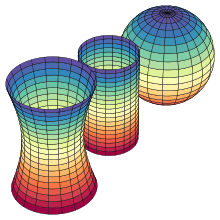Our website is made possible by displaying online advertisements to our visitors.
Please consider supporting us by disabling your ad blocker.
Gaussian curvature


In differential geometry, the Gaussian curvature or Gauss curvature Κ of a smooth surface in three-dimensional space at a point is the product of the principal curvatures, κ1 and κ2, at the given point: For example, a sphere of radius r has Gaussian curvature 1/r2 everywhere, and a flat plane and a cylinder have Gaussian curvature zero everywhere. The Gaussian curvature can also be negative, as in the case of a hyperboloid or the inside of a torus.
Gaussian curvature is an intrinsic measure of curvature, meaning that it could in principle be measured by a 2-dimensional being living entirely within the surface, because it depends only on distances that are measured “within” or along the surface, not on the way it is isometrically embedded in Euclidean space. This is the content of the Theorema egregium.
Gaussian curvature is named after Carl Friedrich Gauss, who published the Theorema egregium in 1827.
Previous Page Next Page



